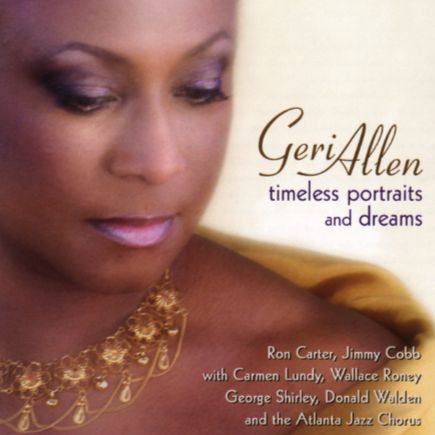Pianiste et compositrice américaine au parcours aussi riche qu’exigeant, Geri Allen s’est imposée comme l’une des figures essentielles du jazz contemporain. Sa virtuosité naturelle, alliée à une curiosité constante et à un profond engagement artistique, lui a permis d’ouvrir de nouvelles voies tout en s’ancrant solidement dans la tradition. Dès l’âge de sept ans, elle révèle un talent hors du commun pour le piano, qu’elle développe au fil d’un parcours académique brillant, entre la Howard University et l’Université de Pittsburgh. Elle y bénéficie de l’enseignement de figures majeures comme Kenny Barron et Anthony Braxton, qui contribuent à façonner son style et son approche.
Installée à New York au début des années 1980, Geri Allen intègre rapidement des cercles créatifs dynamiques. Après un passage au sein du groupe The Supreme, elle collabore avec des membres de l’Art Ensemble of Chicago, puis joue un rôle central dans le collectif M-Base, aux côtés de Steve Coleman, Greg Osby ou Cassandra Wilson. Ce mouvement, à la croisée de l’avant-garde et du groove, défend une approche libre, intellectuelle et inventive du jazz, à laquelle Allen apporte une contribution majeure. Son premier album en tant que leader, The Printmakers (1984), est salué pour son audace et sa profondeur émotionnelle.
Si Geri Allen explore dès 1987 des textures plus funky avec Open on All Sides in the Middle, elle s’illustre également dans des contextes plus traditionnels, jouant avec des musiciens comme Charlie Haden, Paul Motian, Oliver Lake, ou encore Bobby Hutcherson, Jack DeJohnette, Lester Bowie et Dave Holland. Sa capacité à dialoguer avec des générations et des esthétiques variées reflète une rare adaptabilité et une intelligence musicale remarquable.
Tout au long de sa carrière, Geri Allen n’a cessé de réinterroger les frontières du jazz, tout en honorant ses racines culturelles. L’album The Gathering (1998) incarne cette démarche, en explorant les thèmes de la diaspora africaine et de la lutte pour la liberté. En 2006, elle compose For the Healing of the Nations, une suite chorale poignante en hommage aux victimes du 11 septembre, interprétée par le chœur Afro Blue Jazz de l’université Howard. La même année, elle rend hommage à Mary Lou Williams avec Zodiac Suite: Revisited, enregistré avec Buster Williams et Billy Hart.
Son disque solo Flying Toward the Sound (2010) confirme l’étendue de son inspiration, entre densité harmonique et liberté narrative. Trois ans plus tard, elle fonde un trio exclusivement féminin avec Terri Lyne Carrington et Esperanza Spalding, qui rencontre un vif succès critique et public. Le style de Geri Allen, profondément personnel, mêle bebop, free jazz, funk, gospel, musiques africaines et caribéennes. Elle y puise la matière d’un langage original, à la fois exigeant, ouvert et profondément enraciné.
Pianista y compositora estadounidense de trayectoria tan rica como rigurosa, Geri Allen se consolidó como una de las figuras esenciales del jazz contemporáneo. Su virtuosismo natural, unido a una curiosidad constante y a un profundo compromiso artístico, le permitió abrir nuevos caminos sin perder de vista las raíces de la tradición. Comenzó a tocar el piano a los siete años, revelando de inmediato un talento excepcional que desarrolló a lo largo de un recorrido académico brillante en la Howard University y la Universidad de Pittsburgh. Allí estudió con maestros de gran relevancia como Kenny Barron y Anthony Braxton, quienes influyeron notablemente en su enfoque musical.
Instalada en Nueva York a principios de los años 80, Geri Allen se integró rápidamente en círculos creativos dinámicos. Tras una etapa con el grupo The Supreme, colaboró con miembros del Art Ensemble of Chicago, y más adelante desempeñó un papel clave dentro del colectivo M-Base, junto a Steve Coleman, Greg Osby y Cassandra Wilson. Este movimiento, en la encrucijada entre la vanguardia y el groove, defendía una visión libre, intelectual e innovadora del jazz, a la que Allen contribuyó con fuerza. Su primer álbum como líder, The Printmakers (1984), fue aclamado por su audacia y profundidad emocional.
A partir de 1987, con Open on All Sides in the Middle, exploró sonoridades más funk, sin abandonar los contextos más ortodoxos, tocando con músicos como Charlie Haden, Paul Motian, Oliver Lake, así como con Bobby Hutcherson, Jack DeJohnette, Lester Bowie y Dave Holland. Su capacidad para dialogar con distintas generaciones y estéticas revela una adaptabilidad poco común y una inteligencia musical notable.
A lo largo de su carrera, Geri Allen nunca dejó de cuestionar los límites del jazz, al tiempo que honraba sus raíces culturales. El álbum The Gathering (1998) ejemplifica esta búsqueda, abordando temas como la diáspora africana y las luchas por la libertad. En 2006 compuso For the Healing of the Nations, una suite coral conmovedora en homenaje a las víctimas del 11 de septiembre, interpretada por el coro Afro Blue Jazz de la Universidad de Howard. Ese mismo año rindió tributo a Mary Lou Williams con Zodiac Suite: Revisited, junto a Buster Williams y Billy Hart.
Su álbum en solitario Flying Toward the Sound (2010) confirmó la amplitud de su inspiración, combinando densidad armónica y libertad narrativa. Tres años más tarde, fundó un trío femenino junto a Terri Lyne Carrington y Esperanza Spalding, que recibió gran reconocimiento tanto de la crítica como del público. El estilo de Geri Allen, profundamente personal, fusiona bebop, free jazz, funk, góspel y músicas africanas y caribeñas, dando forma a un lenguaje musical original, exigente, abierto y profundamente enraizado.
Geri Allen: una voce di primo piano del jazz contemporaneo, tra eredità e innovazione
Pianista e compositrice statunitense dal percorso tanto ricco quanto rigoroso, Geri Allen si è affermata come una delle figure centrali del jazz contemporaneo. Dotata di un virtuosismo naturale e guidata da una curiosità instancabile e da un forte impegno artistico, ha saputo aprire nuove strade senza mai perdere il legame con la tradizione. Inizia a suonare il pianoforte all’età di sette anni, dimostrando subito un talento straordinario, che coltiva attraverso studi brillanti alla Howard University e all’Università di Pittsburgh. Qui si forma sotto la guida di grandi maestri come Kenny Barron e Anthony Braxton, che contribuiscono a plasmare il suo stile e la sua visione musicale.
Stabilitasi a New York all’inizio degli anni ’80, Geri Allen entra rapidamente in contatto con ambienti creativi dinamici. Dopo un’esperienza con il gruppo The Supreme, collabora con membri dell’Art Ensemble of Chicago e gioca un ruolo fondamentale nel collettivo M-Base, insieme a Steve Coleman, Greg Osby e Cassandra Wilson. Questo movimento, all’incrocio tra avanguardia e groove, promuoveva una concezione libera, intellettuale e sperimentale del jazz, a cui Allen offre un contributo decisivo. Il suo primo album da leader, The Printmakers (1984), viene accolto con entusiasmo per la sua audacia e profondità emotiva.
Nel 1987 sperimenta sonorità più funky con Open on All Sides in the Middle, pur continuando a frequentare contesti più ortodossi, collaborando con musicisti come Charlie Haden, Paul Motian, Oliver Lake, ma anche Bobby Hutcherson, Jack DeJohnette, Lester Bowie e Dave Holland. La sua capacità di dialogare con musicisti di generazioni e stili differenti riflette una straordinaria versatilità e intelligenza musicale.
Nel corso della sua carriera, Geri Allen ha costantemente interrogato i confini del jazz, rimanendo fedele alle sue radici culturali. L’album The Gathering (1998) ne è un esempio eloquente, affrontando temi legati alla diaspora africana e alle lotte per la libertà. Nel 2006 compone For the Healing of the Nations, una suite corale intensa dedicata alle vittime dell’11 settembre, eseguita dal coro Afro Blue Jazz dell’università di Howard. Nello stesso anno rende omaggio a Mary Lou Williams con Zodiac Suite: Revisited, registrato insieme a Buster Williams e Billy Hart.
Con l’album solista Flying Toward the Sound (2010), conferma la vastità della sua ispirazione, tra densità armonica e libertà espressiva. Nel 2013 fonda un trio femminile con Terri Lyne Carrington ed Esperanza Spalding, ottenendo grande successo di pubblico e critica. Lo stile di Geri Allen, profondamente personale, unisce bebop, free jazz, funk, gospel e musiche africane e caraibiche, dando vita a un linguaggio originale, esigente, aperto e fortemente radicato.
An American pianist and composer with a rich and demanding artistic path, Geri Allen established herself as one of the most vital figures in contemporary jazz. Her natural virtuosity, paired with unrelenting curiosity and deep artistic commitment, allowed her to forge new directions while remaining grounded in tradition. She began playing piano at the age of seven, quickly revealing exceptional talent that she cultivated through outstanding academic training at Howard University and the University of Pittsburgh. There, she studied under masters like Kenny Barron and Anthony Braxton, whose influence helped shape her musical voice.
Relocating to New York in the early 1980s, Geri Allen soon immersed herself in vibrant creative circles. After a stint with The Supreme, she collaborated with members of the Art Ensemble of Chicago and became a key figure in the M-Base collective alongside Steve Coleman, Greg Osby, and Cassandra Wilson. This movement, rooted in both avant-garde and groove, championed a free-thinking, exploratory approach to jazz, to which Allen made a significant contribution. Her debut album as leader, The Printmakers (1984), was praised for its boldness and emotional depth.
In 1987, with Open on All Sides in the Middle, she ventured into funkier textures, while continuing to shine in more traditional contexts, performing with musicians such as Charlie Haden, Paul Motian, Oliver Lake, and jazz greats like Bobby Hutcherson, Jack DeJohnette, Lester Bowie, and Dave Holland. Her ability to engage with musicians across generations and styles underscored a rare adaptability and musical intelligence.
Throughout her career, Geri Allen consistently challenged the boundaries of jazz while honoring its cultural roots. Her 1998 album The Gathering exemplifies this approach, exploring themes of the African diaspora and struggles for freedom. In 2006, she composed For the Healing of the Nations, a moving choral suite in tribute to the victims of September 11, performed by the Afro Blue Jazz Choir at Howard University. That same year, she paid tribute to Mary Lou Williams with Zodiac Suite: Revisited, recorded with Buster Williams and Billy Hart.
Her solo album Flying Toward the Sound (2010) reaffirmed the depth of her inspiration, balancing harmonic complexity with narrative freedom. In 2013, she formed an all-women trio with Terri Lyne Carrington and Esperanza Spalding, achieving both critical and popular acclaim. Geri Allen’s deeply personal style fused bebop, free jazz, funk, gospel, and African and Caribbean music into a distinctive language — one that is demanding, expansive, and profoundly rooted.


